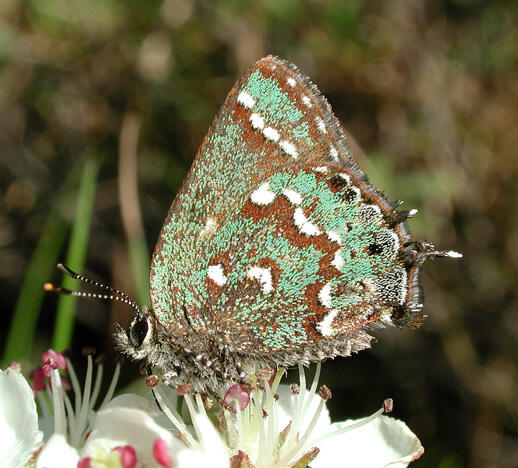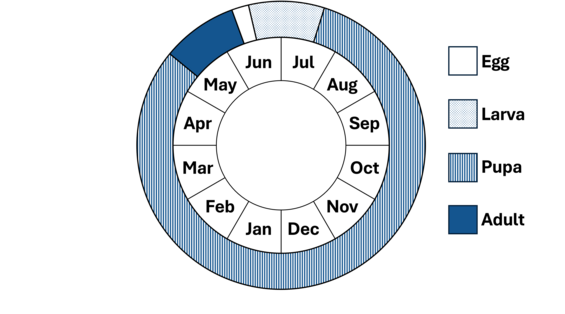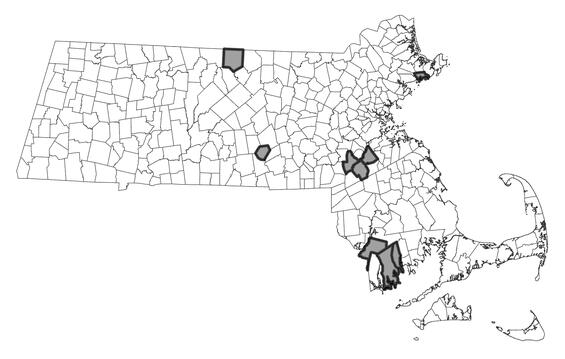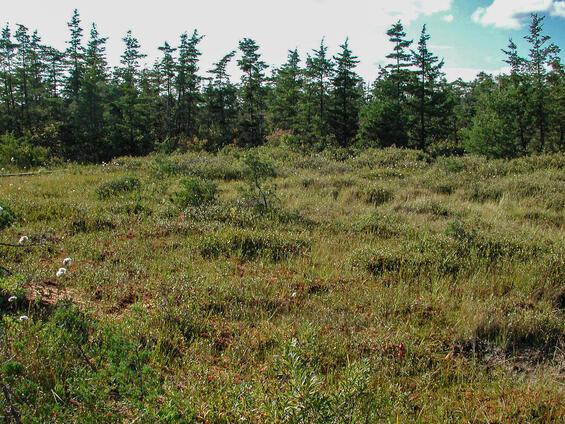- Scientific name: Callophrys hesseli
- Species of Greatest Conservation Need (MA State Wildlife Action Plan)
- Special Concern (MA Endangered Species Act)
Description

Hessel’s hairstreak (Callophrys hesseli)
Hessel’s hairstreak (Callophrys hesseli) is a lycaenid butterfly with a wingspan of 26-28 mm (1.0-1.1 in)(Opler 1998). Like most gossamer-wings, Hessel’s hairstreak rests with wings folded above its back. The upper side of the wings, hidden in this position, are uniform dark brown in color. On the underside, the wings have a reddish-brown ground color overlaid with bright, bluish-green scales and white spot lines; the costal white spot on the forewing is set outward. The reddish-brown ground color is not overlaid with bluish-green adjacent to the white spot lines. Hessel’s hairstreak is similar to the juniper hairstreak (Callophrys gryneus); however, the green scales of the juniper hairstreak are lighter, yellowish-green, and the costal white spot on the forewing is not set outward. Also, the green scales of the juniper hairstreak are more extensive, touching the white spot lines, or nearly so, without reddish-brown patches adjacent to the white spot lines as in Hessel’s hairstreak.
Life cycle and behavior

In Massachusetts, adult Hessel's hairstreak butterflies fly from early May through early June. Eggs are laid on branch tips of Atlantic white cedar (Chamaecyparis thyoides). Larvae feed on new growth of the host plant, pupating by July; pupae overwinter. Hessel's hairstreak is often observed while feeding on flower nectar. Though the butterflies typically remain in the cedar swamp and feed at flowers of highbush blueberry (Vaccinium corymbosum) or chokeberries (Aronia spp.), butterflies may be seen near the swamp in nearby fields, yards, and roadsides, feeding at other flowers. Usually no more than one to a few Hessel's hairstreaks are encountered, though dozens of individuals may be seen in exceptional circumstances (Beck & Garnett 1983).
Distribution and abundance
Hessel's hairstreak is spottily distributed along the Atlantic coastal plain from southern Maine south to the Florida panhandle; areas most densely inhabited by this species include southeastern Massachusetts and Rhode Island, southern New Jersey, and southeastern North Carolina (Schweitzer et al. 2011). In Massachusetts, most colonies are concentrated in southern Worcester, Norfolk, and Bristol Counties.

Distribution in Massachusetts.
1999-2024
Based on records in the Natural Heritage Database.
Habitat
Hessel's hairstreak inhabits Atlantic white cedar swamps and associated shrub swamps and bogs.
Healthy habitats are vital for supporting native wildlife and plants. Explore habitats and learn about conservation and restoration in Massachusetts.

Bog (foreground) with Atlantic white cedar (background), habitat for Hessel's hairstreak butterfly. Habitat managed by DCR at Blue Hills Reservation.
Threats
Hessel's hairstreak is threatened by habitat loss and hydrologic alteration that disrupts the natural seasonal flooding of its habitat. Other potential threats include invasion by exotic plants, introduced generalist parasitoids, aerial insecticide spraying, clear-cut timber harvest, and excessive deer browse of Atlantic white cedar saplings. The effect of a warming climate may not be detrimental to this species in Massachusetts; its range extends south to Florida, suggesting adaptation to warm temperatures.
Conservation
Land protection and habitat management are the primary conservation needs of this species in Massachusetts. In particular, Atlantic white cedar swamps (and associated shrub swamps and bogs) should be conserved, restored, and managed to maintain habitat for this species and other rare and threatened species dependent on such habitat.
Survey and monitoring
The distribution of Hessel's hairstreak in Atlantic white cedar swamps is well documented. Known populations of this species should be surveyed to document persistence at least once every 25 years; every 10 years is more desirable when practicable.
Management
Management of Atlantic white cedar swamps (and associated shrub swamps and bogs) should include: restoring and/or maintaining natural hydrology; control of invasive exotic plants; and silviculture of Atlantic white cedar to promote a diversity of age classes, from saplings to mature trees. Shrub and bog openings in the swamp should be maintained and the growth of nectar sources such as highbush blueberry (Vaccinium corymbosum) and chokeberries (Aronia spp.) promoted. Habitat condition should be monitored and management adapted as needed.
Research needs
The natural history and conservation needs of Hessel's hairstreak are relatively well known. However, the future effects of a warming climate on this species are unpredictable and should be documented.
References
Beck, A.F. and W.J. Garnett. 1983. Distribution and notes on the Great Dismal Swamp population of Mitoura hesseli Rawson and Ziegler (Lycaenidae). Journal of the Lepidopterists’ Society 37(4): 289-300.
Opler, P.A. 1998. A Field Guide to Eastern Butterflies. Peterson Field Guide Series. Houghton Mifflin, Boston, Massachusetts. 486 pp.
Schweitzer, D.F., M.C. Minno, and D.L. Wagner. 2011. Rare, Declining, and Poorly Known Butterflies and Moths (Lepidoptera) of Forests and Woodlands in the Eastern United States. Forest Service, U.S. Dept. of Agriculture, Washington, DC. 517 pp.
Contact
| Date published: | March 6, 2025 |
|---|